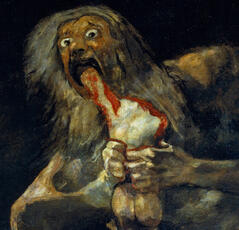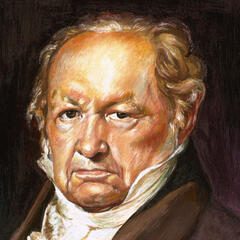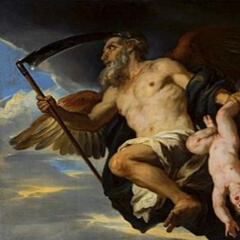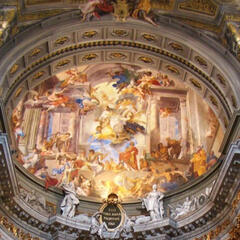Saturn Devouring His Son

"Saturn Devouring His Son" is one of Francisco Goya's most famous and haunting paintings. Here's your 5-minute breakdown of this iconic artwork:
Background

Francisco Goya (1746-1828) was a renowned Spanish painter and printmaker, often considered both the last of the Old Masters and the first of the moderns. His work spans various styles, from Rococo to Romanticism.
Description
The painting depicts the Titan Cronus (often confused with the Roman god Saturn) in a frenzied state, consuming one of his children. The scene is gruesome, with Cronus gripping the body of his son, whose head and part of his arm have already been eaten. The Titan's wide eyes and the dark, murky background add to the painting's eerie atmosphere.
Interpretation
The painting is based on the Greek myth wherein Cronus, fearing a prophecy that he would be overthrown by one of his children, devoured each of them upon their birth. However, his wife Rhea managed to save their youngest child, Zeus, who eventually fulfilled the prophecy by overthrowing Cronus and the other Titans.

The Nature of Time: Cronus, or Saturn in Roman mythology, was not only a deity associated with destructive consumption but also with time. The act of devouring his child can be seen as a representation of the inexorable passage of time, which consumes all things. This interpretation is especially poignant considering Goya's advanced age when he created the painting.

The Ouroboros: An ancient symbol depicting a serpent or dragon eating its tail, the Ouroboros represents the cyclical nature of life, death, and rebirth and the eternal nature of the universe. In "Saturn Devouring His Son," the act of consumption can be seen as a twisted representation of this cycle.
Political Allegory: Given the political upheavals of Goya's time, some interpretations suggest the painting is a commentary on the self-destructive nature of political power. Just as Saturn consumed his children to prevent being overthrown, rulers and regimes might destroy the very things that could ensure their legacy to maintain power.
Psychological Depths: The sheer horror depicted, combined with the intimate setting in Goya's own home, suggests a deep psychological exploration. It's as if Goya was confronting his fears, anxieties, and the darkest corners of his psyche.
Context
"Saturn Devouring His Son" is one of Goya's "Black Paintings," a series of dark and mysterious works that he painted directly onto the walls of his house, known as the Quinta del Sordo (House of the Deaf Man), between 1819 and 1823. These paintings were not commissioned; instead, they seem to have been a personal expression of Goya's despair, possibly influenced by his failing health, political turmoil in Spain, and other personal tragedies.

Goya lived through the tumultuous period of the Peninsular War, where Spain, with the help of Britain, fought against Napoleonic France. The horrors of this war, especially the atrocities committed by both sides, deeply affected Goya. By the time he painted the "Black Paintings," Goya had endured several severe illnesses, which left him deaf and in a state of chronic pain and melancholy. His deteriorating health and isolation might have contributed to the dark themes of these works.
Technique and Style

Influence: The exaggerated form of the figures, especially the elongated limbs of the child, can be linked to Mannerist art, which often distorted the human figure for emotional effect. The dramatic use of light and shadow, as well as the intense emotionalism of the piece, are reminiscent of the Baroque style.
Brushwork: Goya's brushwork in this painting is loose and almost frenzied, adding to the chaotic and nightmarish quality of the scene.
Color Palette: The limited, dark color palette enhances the grim mood. The pale flesh of the son contrasts starkly with the surrounding darkness, making the act of consumption even more jarring.
Composition: The figure of Saturn dominates the canvas, his wild eyes and gaping mouth drawing the viewer into the horror of the moment. The child's limp body, partially devoured, adds to the tragic horror of the scene.
Legacy
After Goya's death, the painting, along with the other Black Paintings, was transferred to canvas and is now housed in the Museo del Prado in Madrid. It remains one of the most studied and referenced works in the history of art, symbolizing the darker aspects of the human psyche and the depths of human experience.
Your Grokking Art team 👋
© Grokking Art. All right reserved.